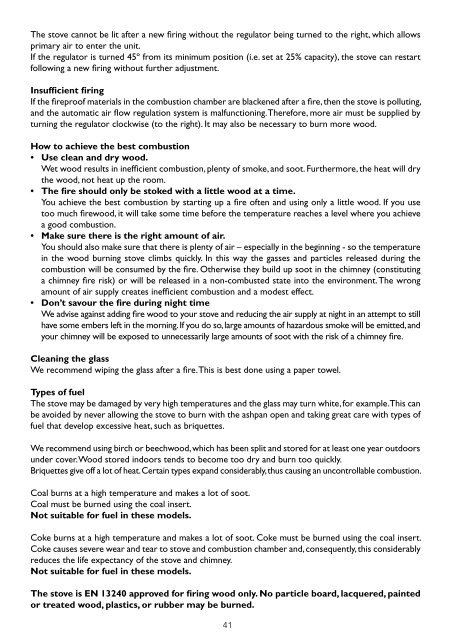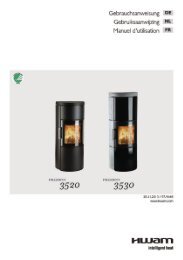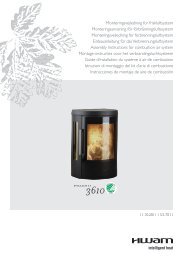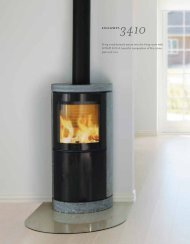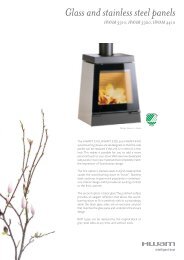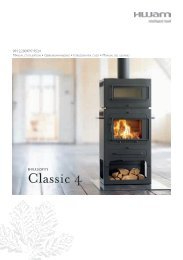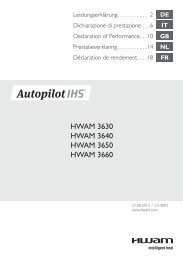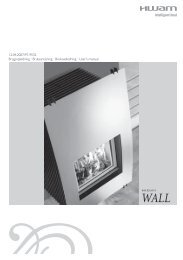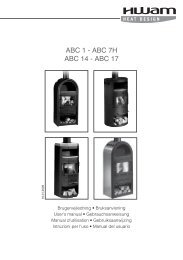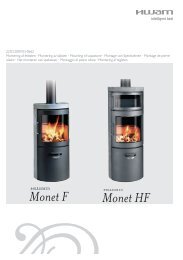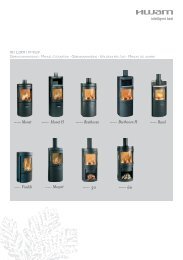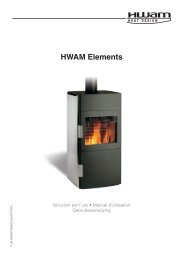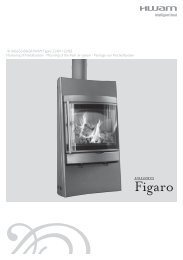Brugsvejledning Bruksanvisning Bruksveiledning User's ... - Hwam
Brugsvejledning Bruksanvisning Bruksveiledning User's ... - Hwam
Brugsvejledning Bruksanvisning Bruksveiledning User's ... - Hwam
Create successful ePaper yourself
Turn your PDF publications into a flip-book with our unique Google optimized e-Paper software.
The stove cannot be lit after a new firing without the regulator being turned to the right, which allowsprimary air to enter the unit.If the regulator is turned 45º from its minimum position (i.e. set at 25% capacity), the stove can restartfollowing a new firing without further adjustment.Insufficient firingIf the fireproof materials in the combustion chamber are blackened after a fire, then the stove is polluting,and the automatic air flow regulation system is malfunctioning. Therefore, more air must be supplied byturning the regulator clockwise (to the right). It may also be necessary to burn more wood.How to achieve the best combustion• Use clean and dry wood.Wet wood results in inefficient combustion, plenty of smoke, and soot. Furthermore, the heat will drythe wood, not heat up the room.• The fire should only be stoked with a little wood at a time.You achieve the best combustion by starting up a fire often and using only a little wood. If you usetoo much firewood, it will take some time before the temperature reaches a level where you achievea good combustion.• Make sure there is the right amount of air.You should also make sure that there is plenty of air – especially in the beginning - so the temperaturein the wood burning stove climbs quickly. In this way the gasses and particles released during thecombustion will be consumed by the fire. Otherwise they build up soot in the chimney (constitutinga chimney fire risk) or will be released in a non-combusted state into the environment. The wrongamount of air supply creates inefficient combustion and a modest effect.• Don’t savour the fire during night timeWe advise against adding fire wood to your stove and reducing the air supply at night in an attempt to stillhave some embers left in the morning. If you do so, large amounts of hazardous smoke will be emitted, andyour chimney will be exposed to unnecessarily large amounts of soot with the risk of a chimney fire.Cleaning the glassWe recommend wiping the glass after a fire. This is best done using a paper towel.Types of fuelThe stove may be damaged by very high temperatures and the glass may turn white, for example. This canbe avoided by never allowing the stove to burn with the ashpan open and taking great care with types offuel that develop excessive heat, such as briquettes.We recommend using birch or beechwood, which has been split and stored for at least one year outdoorsunder cover. Wood stored indoors tends to become too dry and burn too quickly.Briquettes give off a lot of heat. Certain types expand considerably, thus causing an uncontrollable combustion.Coal burns at a high temperature and makes a lot of soot.Coal must be burned using the coal insert.Not suitable for fuel in these models.Coke burns at a high temperature and makes a lot of soot. Coke must be burned using the coal insert.Coke causes severe wear and tear to stove and combustion chamber and, consequently, this considerablyreduces the life expectancy of the stove and chimney.Not suitable for fuel in these models.The stove is EN 13240 approved for firing wood only. No particle board, lacquered, paintedor treated wood, plastics, or rubber may be burned.41


